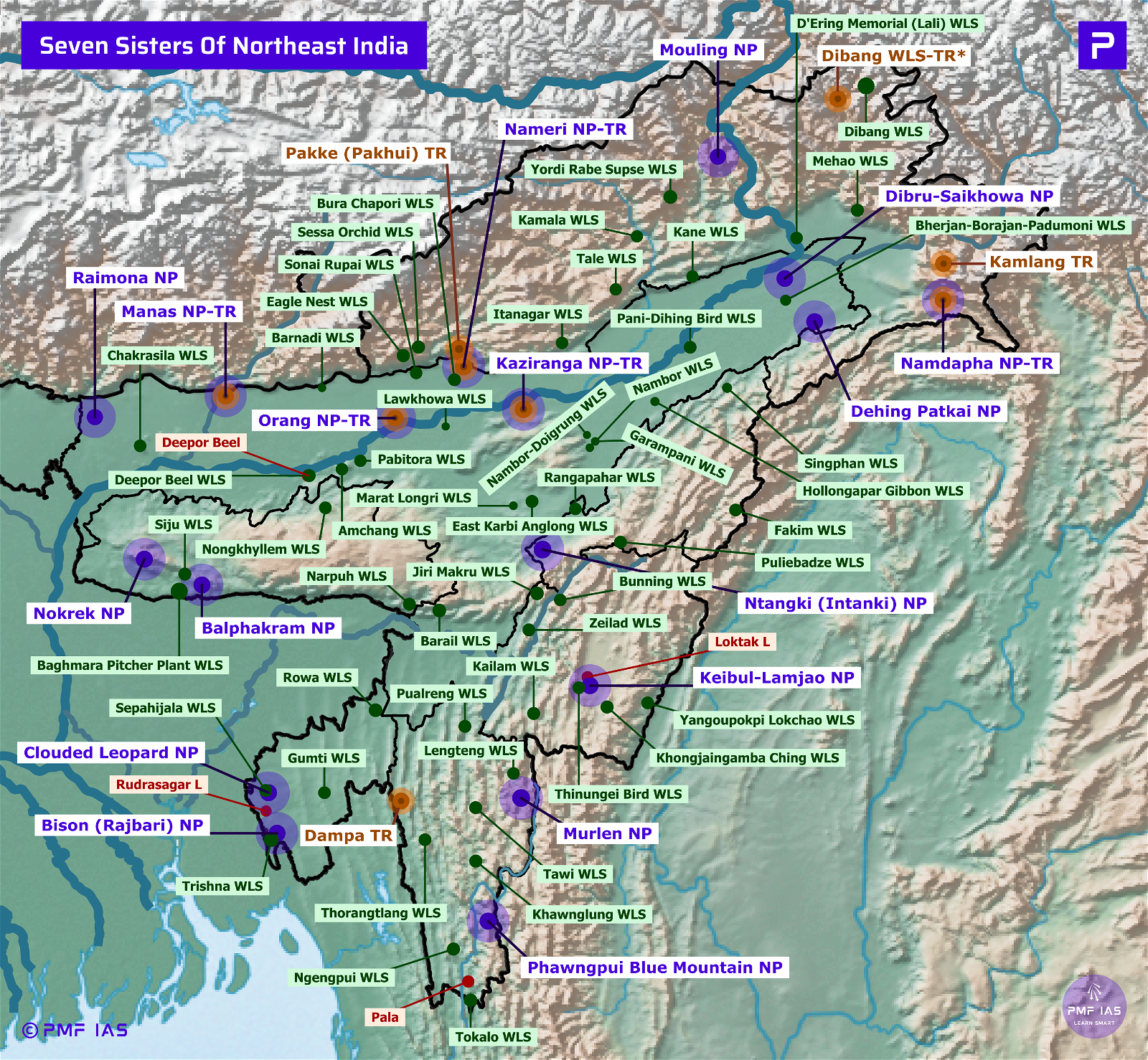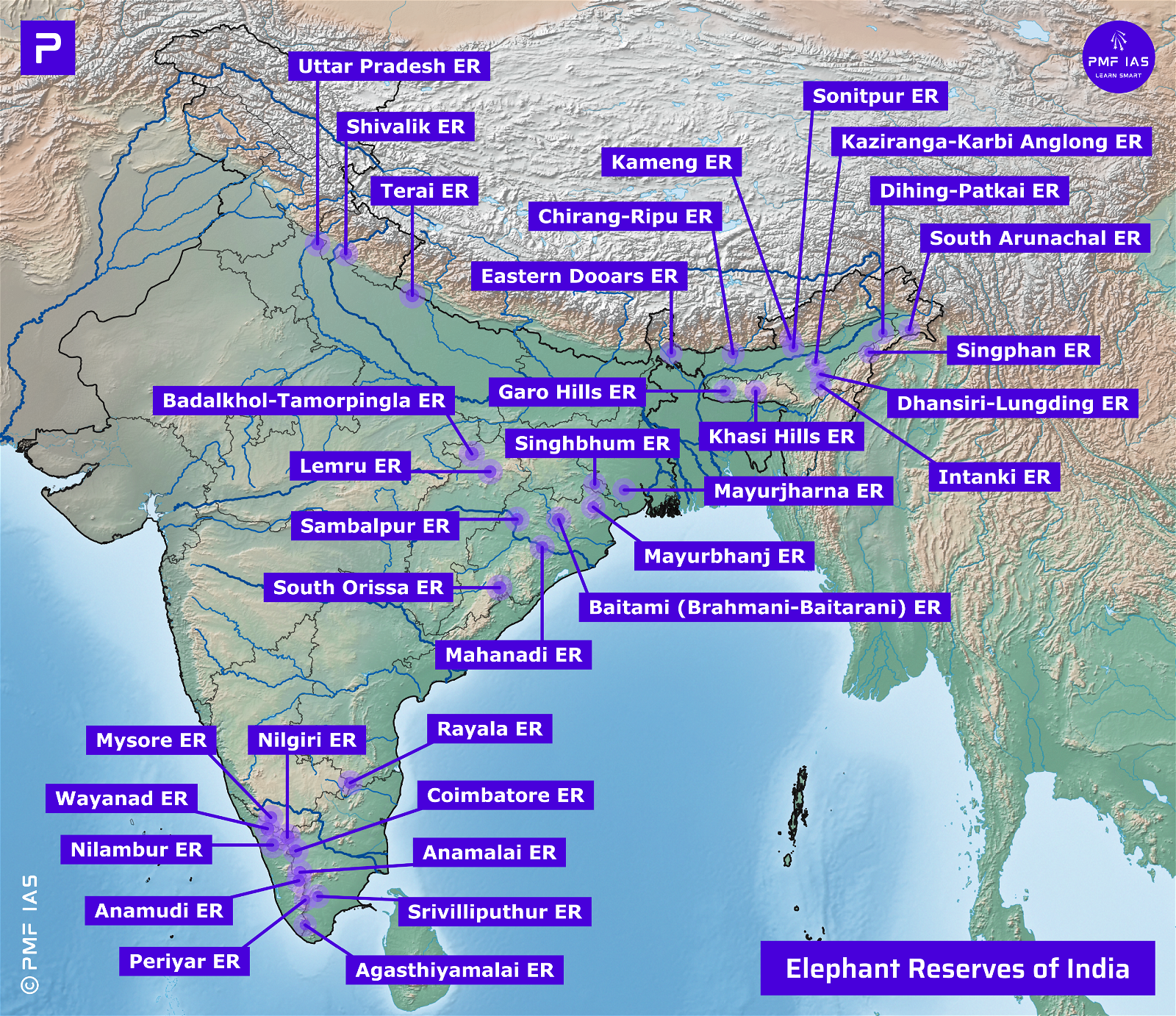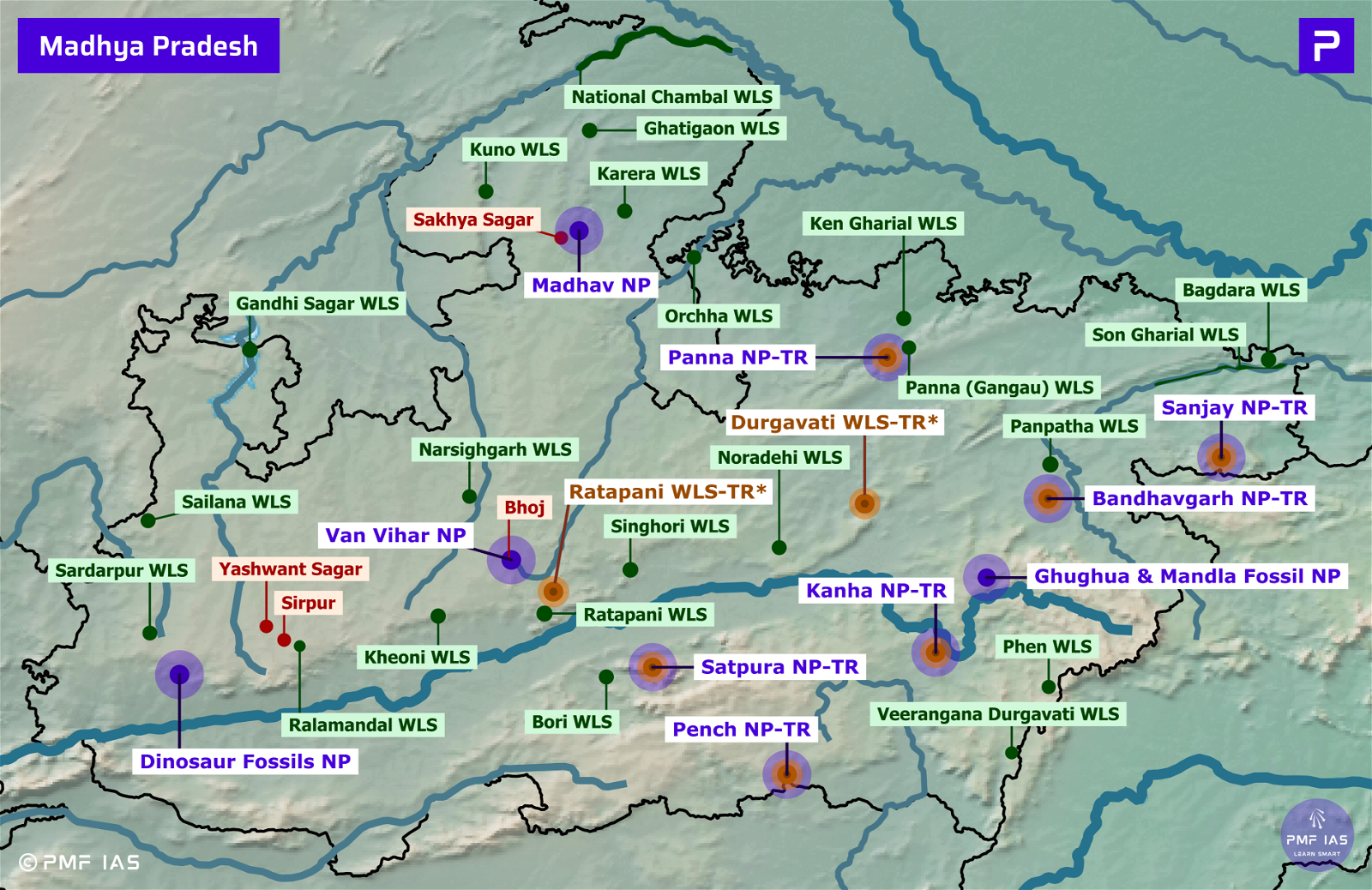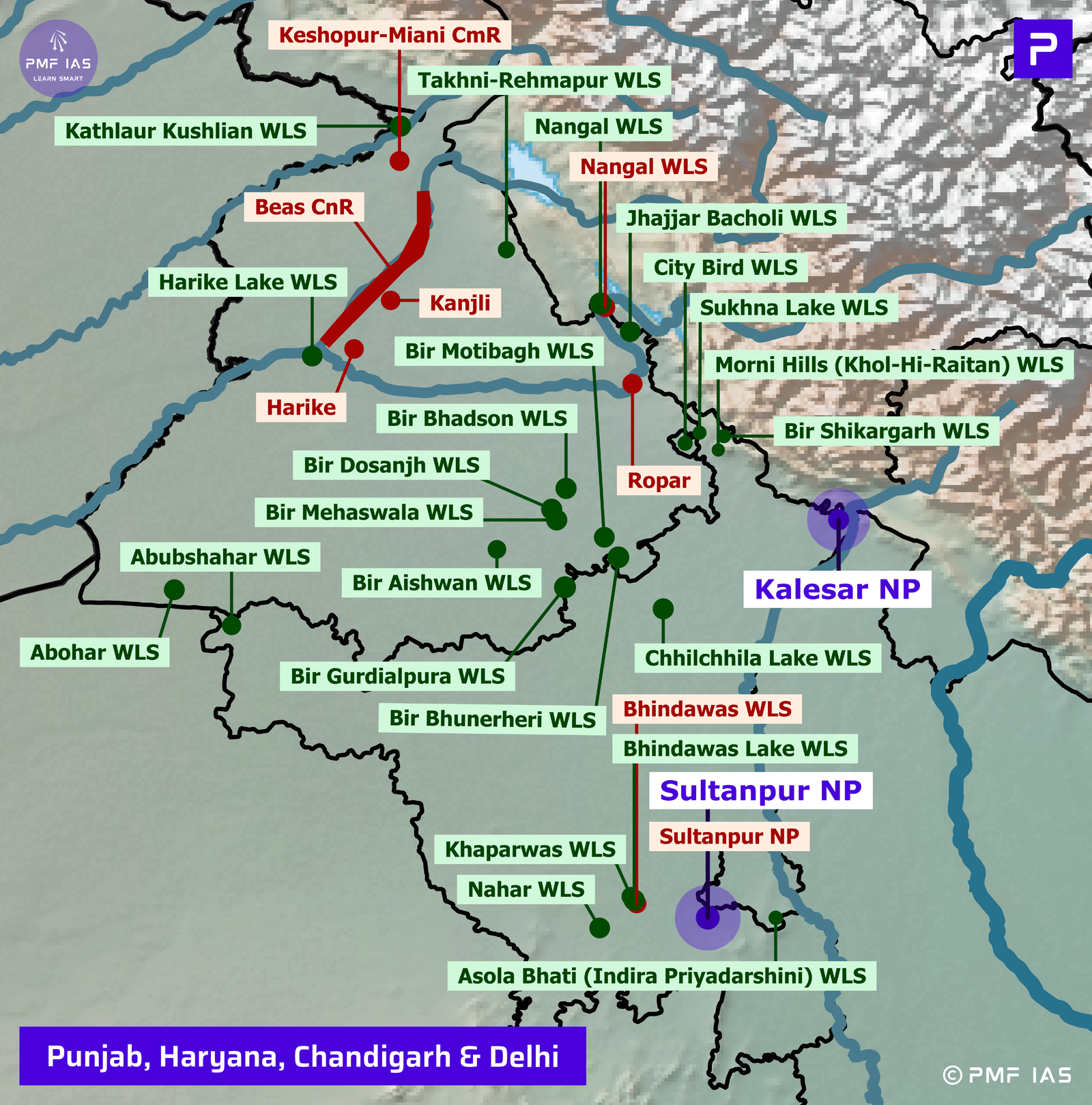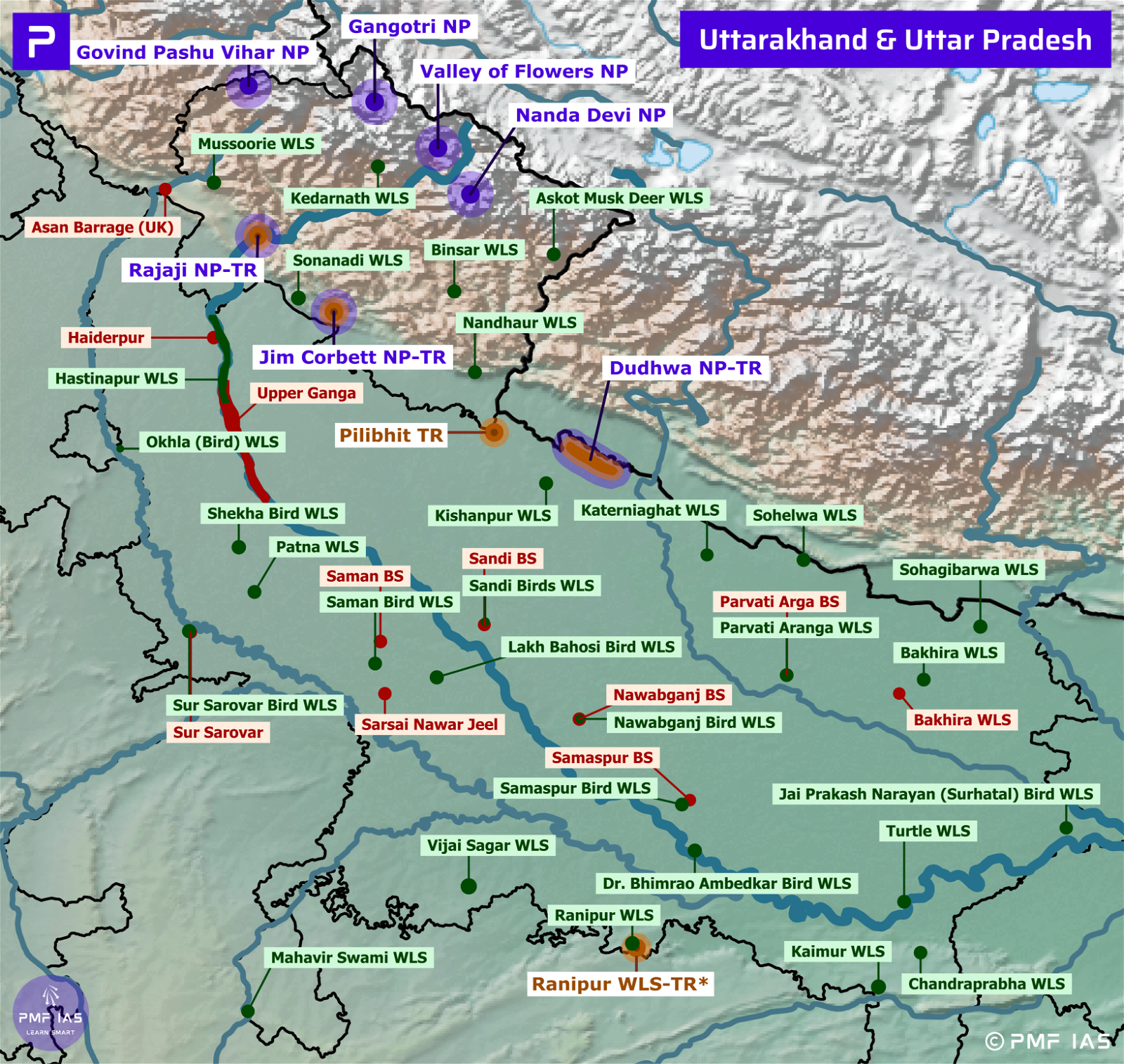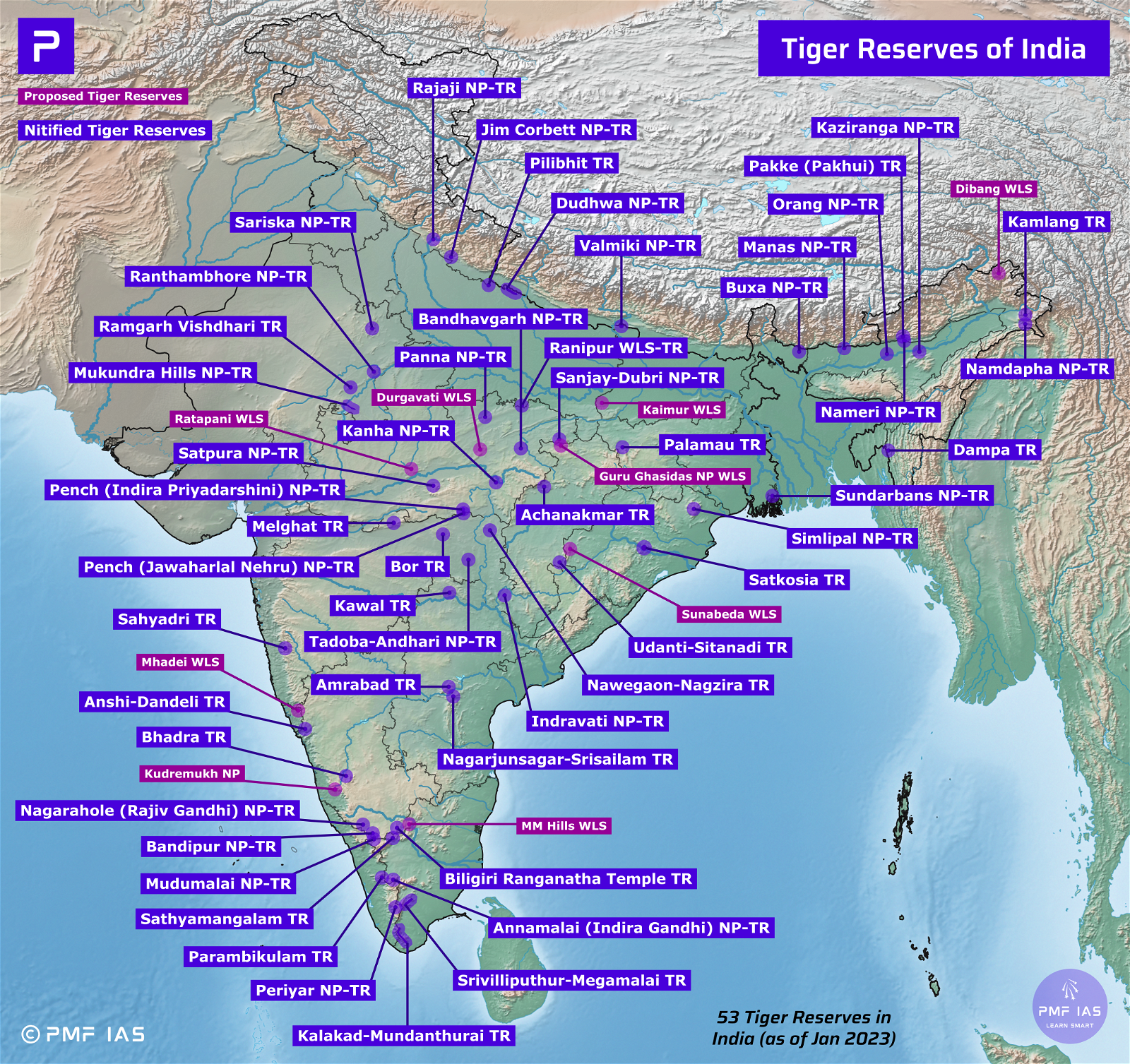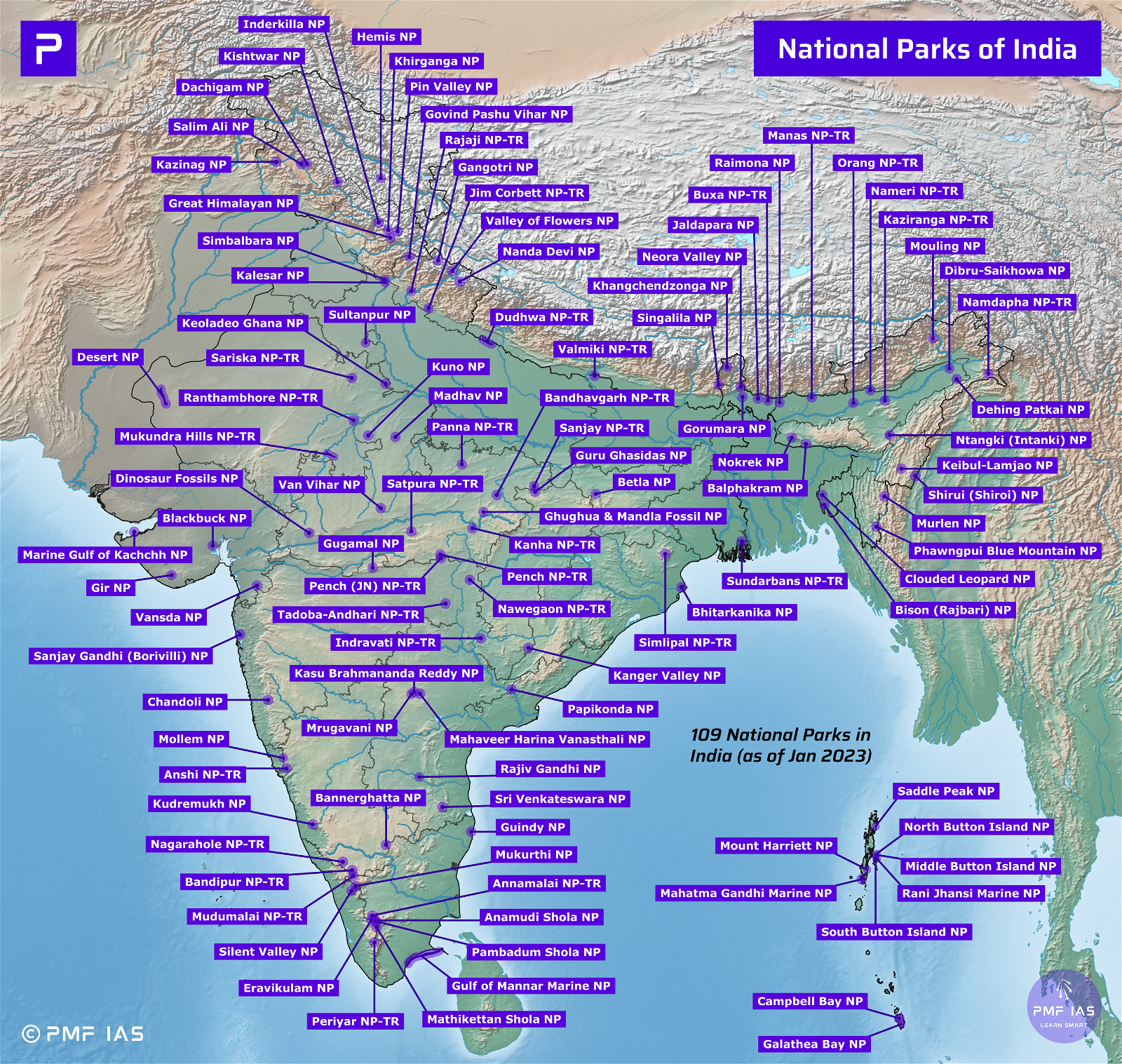
Karnataka National Parks, Tiger Reserves, Wildlife Sanctuaries & Ramsar Sites
Subscribe to Never Miss an Important Update! Assured Discounts on New Products!
Must Join PMF IAS Telegram Channel & PMF IAS History Telegram Channel
Last updated on April 30, 2024 2:34 PM
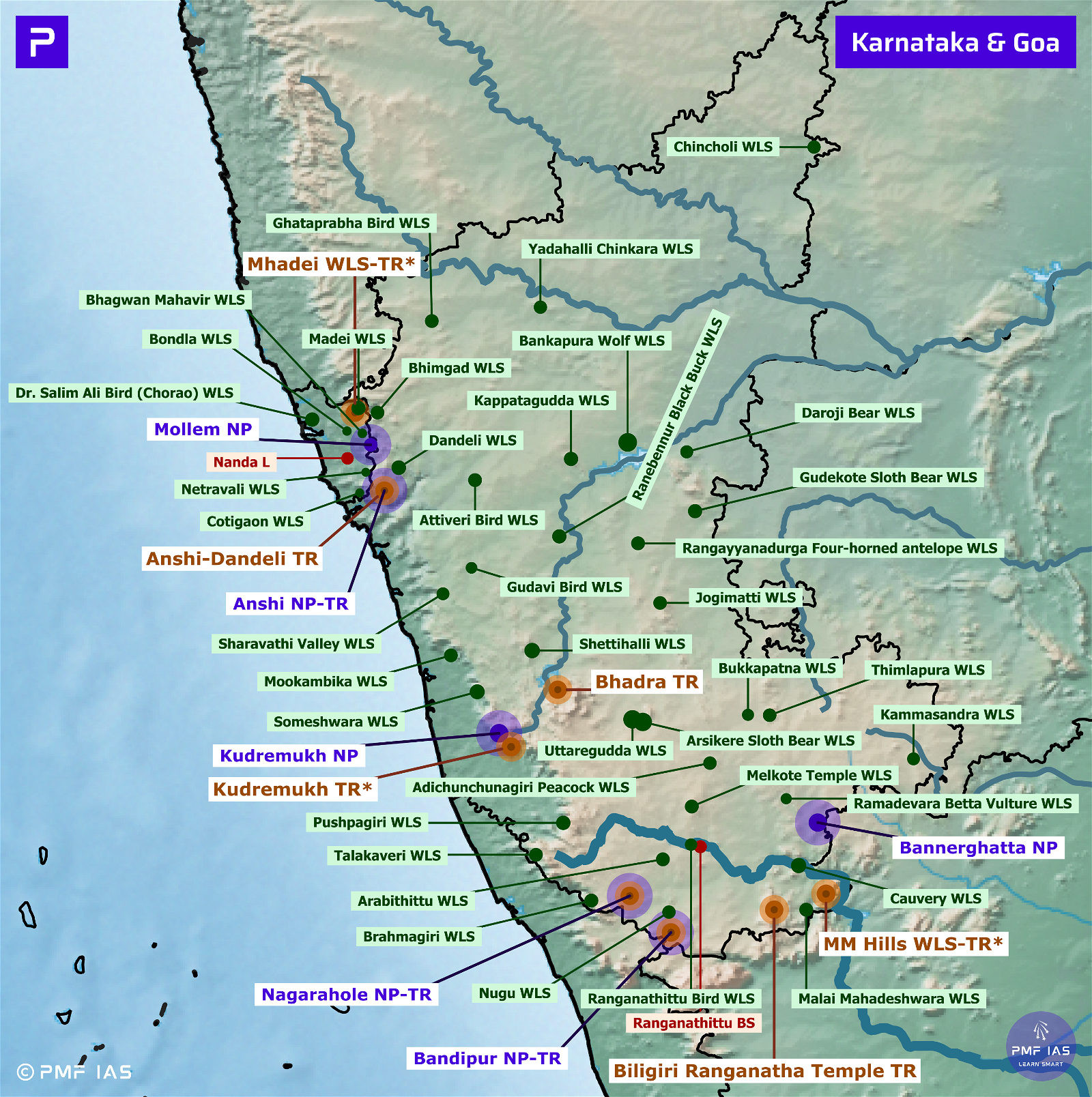
Anshi National Park and Dandeli-Anshi Tiger Reserve (Kali Tiger Reserve)
- Anshi National Park is located on the banks of Kali River in the Western Ghats. It is a part of the Dandeli Wildlife Sanctuary.
- Anshi National Park and Dandeli Wildlife Sanctuary were together granted the status of Project Tiger Tiger Reserve, and were declared as ‘Anshi-Dandeli Tiger Reserve’ (which is now renamed as Kali Tiger Reserve).
- Vegetation: Deciduous forest & montane rainforest.
- Major Flora: cinnamon, bamboo, eucalyptus.
- Major Fauna: Elephant (EN), Bengal tiger (EN), black panther (black colour variant of leopard; VU), wild boars, bonnet macaque, Malabar civet, Malabar giant squirre.
- Major Avifauna: Adjutant stork, great hornbill.
Bandipur National Park, Tiger Reserve
- Together with Nagarhole National Park, Mudumalai National Park (TN) and Wayanad Wildlife Sanctuary (Kerala), it is part of the Nilgiri Biosphere Reserve.
- Kabini River (a tributary of the Cauvery River) separates the National Park from Nagarhole National Park.
- Vegetation: Dry & moist deciduous forests, and shrubs.
- Major Flora: Teak, rosewood, sandalwood, clumping bamboo, Indian laurel and kadam tree.
- Major Fauna: Indian elephants, gaurs, tigers, sloth bears, chausinghas, dholes, chital, sambar, gray langurs.
- Threats: Wildlife fatalities by speeding vehicles, cattle grazing, transmission of diseases from cattle to wildlife, deforestation and habitat fragmentation, and invasive species (e.g, Lantana and Parthenium).
- There is a ban on traffic from 9 pm to 6 am of dusk to dawn to help bing down the death rate of wildlife.
Bannerghatta National Park
- It is part of a wildlife corridor for elephants which connects Biligirirangana Hills and Sathyamangalam forest.
- Vegetation: Moist deciduous forest and scrubland.
- Major Flora: Sandalwood, bamboo, eucalyptus.
- Major Fauna: Elephants, Bengal tiger, gaur, leopard, sloth bear, Indian gazelle, spotted deer, bonnet macaque.
- Major Avifauna: Flamingo, pelican.
- Threats: Illegal mining of granite close to critical elephant corridors inside the National Park.
- A portion of the National Park is converted into Bannerghatta Biological Park. The Biological Park has a zoo, a butterfly enclosure, a snake house and a safari park. It shelters mammals such as Indian tigers and lions.
Bhadra Tiger Reserve, Wildlife Sanctuary
- It is about 100 km to the east of Kudremukh National Park. It is surrounded by scenic hills, including the Baba Budangiri hills. Mullayanagiri peak (1,930 m) in the Baba Budangiri hills is the highest peak in Karnataka.
- Hebbe Falls and Manikyadhara Falls are located on the periphery of the sanctuary.
- Vegetation: Semi-evergreen & moist deciduous forests, and shola grasslands.
- Major Flora: Kadam, teak, Indian-laurel, rosewood.
- Major Fauna: Tiger, leopard, Malabar civets, Malabar giant squirrel, spotted deer, muntjac, chevrotain, bonnet macaque, lion-tailed macaque (EN).
- Threats: Iron ore mining, tourism and related construction, the tribal population in the park.
Biligiri Ranganatha Temple TR, Wildlife Sanctuary
- It is the starting point of Eastern Ghats. The Biligiri Ranganatha Hills (BR Hills) connect Eastern Ghats and Western Ghats, and facilitates gene flow between populations of species in these areas.
- Vegetation: Evergreen, deciduous, sholas, and grasslands.
- Major Fauna: Wild elephants, tiger, gaur, sambhar, chital.
- Threats: Quarrying, sandalwood smuggling, elephant poaching.
Kudremukh National Park
- The Tunga River and Bhadra River flow through the National Park. It is proposed to be declared a Tiger Reserve as part of the Bhadra Tiger Reserve.
- Vegetation: Semi-evergreen & moist deciduous forests, and shola grasslands.
- Major Fauna: Malabar civets, Malabar giant squirrels, chevrotain, bonnet macaque, lion-tailed macaque (EN).
- Threats: Iron ore mining, tourism and related construction, tribal population in the park.
Nagarahole (Rajiv Gandhi) National Park, Tiger Reserve
- It is located in the foothills of Western Ghats.
- It is recognized as an Important Bird Area.
- Jenu Kurubas (honey-collecting tribe) live in this park.
- Vegetation: Moist & dry deciduous forests, swamp forests, and bamboo.
- Major Flora: Rosewood, teak, sandalwood and silver oak.
- Major Fauna: Bengal tiger, leopard, Indian elephant, chital, chausingha, gaur, mugger (marsh crocodile).
- Threats: Tourism, fragmentation of forests, poaching.
- In 2020, the pictures of rare black panther Saya caught on camera by photographer Shaaz Jung from the dense forests of Nagarhole went viral.
Q. Which of the following Protected Areas are located in the Cauvery basin?
Select the correct answer using the code given below:
Answer: (Hill in Kannada ==>Betta; Telugu ==> Konda; Tamil ==> Malai); c) All except Papikonda National Park |
Wildlife Sanctuaries of Karnataka
Bhimgad Wildlife Sanctuary
- It is located in the Western Ghats and is the only known breeding area of Wroughton’s free-tailed bat (CR).
- It is contiguous to Madei Wildlife Sanctuary (Goa), Bhagwan Mahaveer Wildlife Sanctuary and Mollem National Park (Goa) and Dandeli Wildlife Sanctuary (Karnataka).
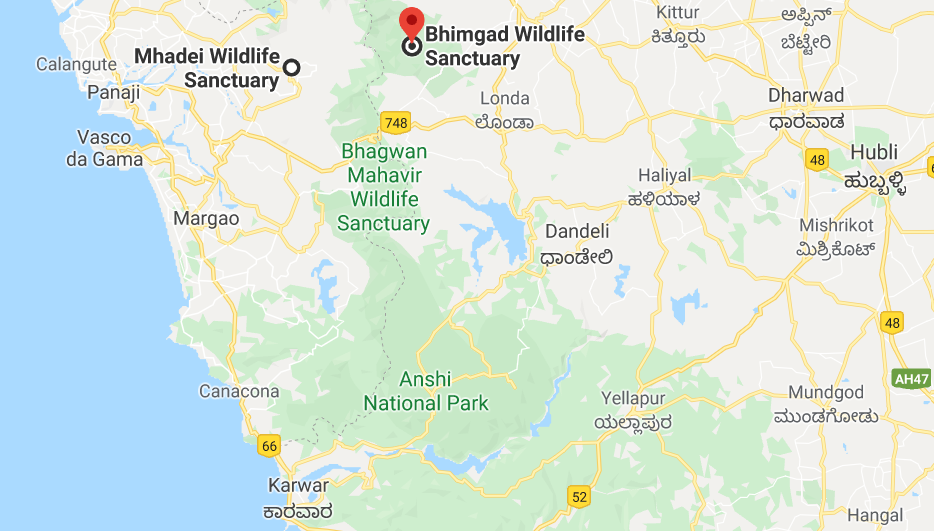
Brahmagiri Wildlife Sanctuary
- It is located in the Western Ghats and is contiguous with the Aralam Wildlife Sanctuary of Kerala.
- Major Fauna: Lion-tailed macaque (EN), Malabar giant squirrel, giant flying squirrel, Nilgiri marten.
Bukkapatna Wildlife Sanctuary
- It is a chinkara sanctuary in Tumakuru district.
Cauvery Wildlife Sanctuary
- It is contiguous with BR Hill Tiger Reserve (Karnataka), Sathyamangalam Tiger Reserve (TN) and Dharmapuri forest (TN).
- Hogenakal Falls and Mekedatu (confluence of Cauvery & Arkavathi Rivers) are important locations of the Wildlife Sanctuary.
- Major Fauna: Tiger, elephant, Malabar giant squirrel, grizzled giant squirrel, mugger crocodile.
Daroji Bear Wildlife Sanctuary
- It is located 15 km from the World Heritage Site of Hampi.
- It was created for the preservation of the sloth bear (VU).
Ghataprabha Bird Wildlife Sanctuary
- Its boundaries enclose a stretch of about 28 km of the Ghataprabha River (a tributary of the Krishna River).
Gudavi Bird Wildlife Sanctuary
- It is a small seasonal lake located in Shimoga district.
Gudekote Sloth Bear Wildlife Sanctuary
- It was created exclusively for the preservation of sloth bear (VU). It is to the south of Daroji Sloth Bear Sanctuary.
Kamasandra Wildlife Sanctuary
- It is recently declared Wildlife Sanctuary. It is located at trijunction of Karnataka, Andhra Pradesh & Tamil Nadu.
Malai Mahadeshwara Wildlife Sanctuary
- It is located in the Eastern Ghats. It has Cauvery Wildlife Sanctuary (Karnataka) to its north and east, Sathyamangalam Tiger Reserve (TN) to its south and BR Hills Temple Tiger Reserve (Karnataka) to its west.
Melkote Temple Wildlife Sanctuary
- It is situated in Mandya district. It was declared as a sanctuary to protect the habitat of Grey Wolf.
Mookambika Wildlife Sanctuary
- It derives its name from the Kollur Mookambika Temple.
- It lies in the Western Ghats and famous Kodachadri Hills are located in the sanctuary.
Pushpagiri Wildlife Sanctuary
- Pushpagiri (Kumara Parvatha,1712 m) is the highest peak in the Wildlife Sanctuary. Mallalli falls and Kote abbe falls (or Mukkodlu falls) are located inside the Wildlife Sanctuary.
Ranebennur Blacbuck Wildlife Sanctuary
-
- It was declared as a Wildlife Sanctuary mainly to protect blackbucks (LC). Great Indian bustards are also observed here.
Ranganathittu Wildlife Sanctuary (BS)
- It is also called Pakshi Kashi of Karnataka located near the historic town of Srirangapattana (near Mysore).
- It is the largest Bird Sanctuary in the state and comprises six islets on the banks of the Cauvery River.
- Major Fauna: Smooth coated otter, common palm civet, mugger crocodile.
- Major Avifauna: Painted stork, Asian openbill stork, common spoonbill, woolly-necked stork, black-headed ibis.
- It receives thousands of migratory birds from Siberia, Latin America and parts of north India during winter.
- It experiences heavy flooding when water is released from Krishna Raja Sagara dam (on Cauvery River) upstream.
Ramadevara Betta Wildlife Sanctuary (Vulture Sanctuary)
- It is India’s first vulture sanctuary.
- It houses Long-billed vulture (Indian Vulture, CR), Egyptian Vulture (EN) and White-rumped vulture (CR).
Rangayyanadurga Wildlife Sanctuary
- It is located in Davanagere district. It is the only sanctuary for four-horned antelopes (chausingha, VU) in Karnataka.
Sharavathi Valley Wildlife Sanctuary
- Sharavati, a westward flowing river, lies entirely in the Western Ghats. The famous Jog Falls is formed by this river. Linganamakki Reservoir is a major part of the Sharavati Valley.
Shettihalli Wildlife Sanctuary
- It is contiguous with the Bhadra Wildlife Sanctuary and Tiger Reserve. The Mandagadde Bird Sanctuary is a part of the Shettihalli Wildlife Sanctuary.
Someshwara Wildlife Sanctuary
- It lies in the Western Ghats. Agumbe (the Cherrapunji of South India) is located in this Wildlife Sanctuary.
Yadahalli Chinkara Wildlife Sanctuary
- It is WLS for chinkaras (Indian Gazelle; LC). It is the first chinkara sanctuary in Karnataka.
Talakaveri Wildlife Sanctuary
- It is the place considered to be the source of the river Kaveri. It is located on Brahmagiri hills.
Thimlapura Wildlife Sanctuary
- It is a conservation reserve for bears in Tumkur district.
Yadahalli Chinkara Wildlife Sanctuary
- It is located in Baglkot district.
- It is established to protect chinkaras (Indian Gazelle; LC).
Others
- Adichunchunagiri (Peacock) Wildlife Sanctuary (BS): Located in Mandya district.
- Arabithittu Wildlife Sanctuary: Located in Mysore district.
- Attiveri Bird Wildlife Sanctuary: Located in Uttara Kannada district.
- Chincholi Wildlife Sanctuary: It is a dryland Wildlife Sanctuary in Kalburgi district.
- Jogimatti Wildlife Sanctuary: A hill station and forest reserve in Chitradurga district.
- Kappathagudda Wildlife Sanctuary: A forest in Gadag district facing a serious threat from illegal mining.
- Nugu Wildlife Sanctuary: It is situated north of Bandipur National Park in Mysore district.
Ramsar Sites of Karnataka (1)
Ranganathituu Bird Sanctuary (IBA)
- It is a part of the Kaveri River in Mandya district.
- Fauna: Mugger Crocodile (VU), Smooth-Coated Otter (VU), Hump-Backed Mahseer (CR)
- Major Avifauna: Painted Stork (NT), Grey Pelican (VU), Black-Headed Ibis (NT)
Last updated on April 30, 2024 2:34 PM





![PMF IAS Environment for UPSC 2022-23 [paperback] PMF IAS [Nov 30, 2021]…](https://pmfias.b-cdn.net/wp-content/uploads/2024/04/pmfiasenvironmentforupsc2022-23paperbackpmfiasnov302021.jpg)

